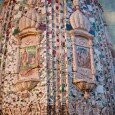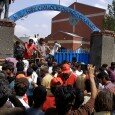By Maryiam Pervaiz –
Punjab CM’s much fancied Metro Bus Service project is high on ambition but not everyone in Lahore is happy
The Metro Bus Service project in Lahore has evoked great debate about its viability notwithstanding Chief Minister Shahbaz Sharif’s coveted endeavour to give the city a modern sheen.
There is also concern about how the project inaugurated by the Mayor of Istanbul sits with culturally Pakistan’s most diversified city and its rich architecture.
Launched on a Build-Operate-Transfer basis in collaboration with Istanbul, the Metro Bus Service is a work in progress but right from the time the construction of some bridges began it created unease among the citizens. It is not difficult to see why: the route of the new bus service within the city has led to great inconvenience for the citizens.
According to historian Dr Mubarik Ali, “Internationally, expansions and new transit systems are always constructed on the outskirts of a city. Likewise, in London, they have still maintained the ardor of the old Oxford Street.”
The 27km long New Metro Bus Route, Phase I from Gajju Matta to Shahdarah transcends into the magnificent architectural monuments of the colonial period. Lahore is identified as the heart of Pakistan; in similar fashion, the monuments of this British Raj are valued as the heart of the city.
As you enter from Shahdarah, Badshahi Mosque, Minar-e-Pakistan and Lahore Fort represent the stature of the city, leaving one awe-struck. As you move along, the vibrance of the Sufi shrine of Data Ganj Baksh will captivate your soul; and the famous Government College, a splendour in itself, where even the late Bollywood film maker Yash Chopra wished to shoot his film. The impact and security of these spectacular buildings is now in jeopardy because of the towering bridge of the Metro Bus Service project.
The Punjab government however, appears keener on the modernity gloss. Sohail Janjua, LDA deputy director PR & Media, says, “After the completion of the new metro, Lahore will be among the few modern metropolitans of the world with Metro Bus Service for its citizens. When this project was being designed and planned, due deliberations were made to minimize its toll on the city’s heritage.”
In compliance with research, once London Metropolitan rejected the construction of an Ismaili Institute of Islamic Study because it was felt such buildings would distort the history of the place. Another issue associated with the ongoing construction of the new metro system is the impediment faced by commuters in reaching their desired destination.
Naeem Ahmed, an employee at a local bank, says, “My job is compromised because every day I get late to the office, and, if I try and take a detour, that costs me double the petrol and twice the time.”
Discussing the misery of the public, Dr Mubarik Ali notes that the design and plan of the metro system was not discussed before its implementation. The LDA deputy director however, counters this predicament by saying, “There is no surgery without pain. The problem is temporary. (Rest assured) the Metro Bus Service is a project of the common man. It is the largest and first of its kind project.”
The Punjab government claims that almost 95 percent of the work has been completed till date but even the second deadline of January 2013 has passed with work on Kalma Chowk, Mozang, Jain Mandir and some of the other major junctions in Lahore still ongoing.
The authorities claim that through the new metro system 20 times more people can travel on one lane of road in buses instead of cars. It has also been stated that travel duration from Gajju Matta to Shahdarah will reduce from two hours plus to just 50 minutes. However, experts suggest that to control the flow of traffic, underground transit system is highly suitable.
Tahir Khan, a commuter, is blunter in his conclusion. “Shahbaz Sharif likes to travel on well constructed roads. That is why he wants to make all these roads that lead to his residence”. Flyovers and highways within the cities make it difficult for the pedestrians to move freely in the cities. The Mayor of Bogotá once said, “Cities are not only for those who can afford cars, but, those who travel by foot have equivalent rights”.
However, Lahore seems to be at odds with this idea. It is one of those metropolitans, where walking in the old city, that is, within the thirteen gates, fosters the magic of the ancient and British era, hence, making it a significant part of the antiquity of this city. But unfortunately these highways and bridges, constructed in the name of modernism, reveal a very complex and mentally unnerving picture of the city.
About the salient features of the new service, the LDA official says, “With the start of the metro, people will travel with protocol in latest articulated air conditioned buses on a signal free track. They will have the convenience of e-ticketing. And there are escalators for them to step up the overhead bridges.”
Some commuters have an issue with priorities. Muhammad Imdad, a labourer, says, “For a poor man, the construction of new roads and new metro bus has no meaning as his primary focus remains to fulfill the bare necessities in this age of inflation. I don’t understand why that is not the focus of the Punjab government.”
Amina Iqbal, a student, who travels on buses from her residence to college, is relieved though. She says, “The metro will make my life much easier as I won’t have to keep changing buses to reach my home now.”
According to Punjab government, 45 buses, each with a capacity of 150 passengers, have been imported and a successful test run by the chief minister proves the success of the project.
Once a quiet, nostalgic and tranquil boulevard, Lahore’s Mall Road has now been turned into a messy and noisy road on account of the recent diversions. Referring to the famous calling Lahore Lahore hai (Lahore is but Lahore!), Dr Mubarik Ali chimes in and says, tongue firmly in cheek, “The changes in the infrastructure of the city have turned it into Lahore Takht-e-Lohar hai (Lahore is the Fortress of Blacksmith).






























































































